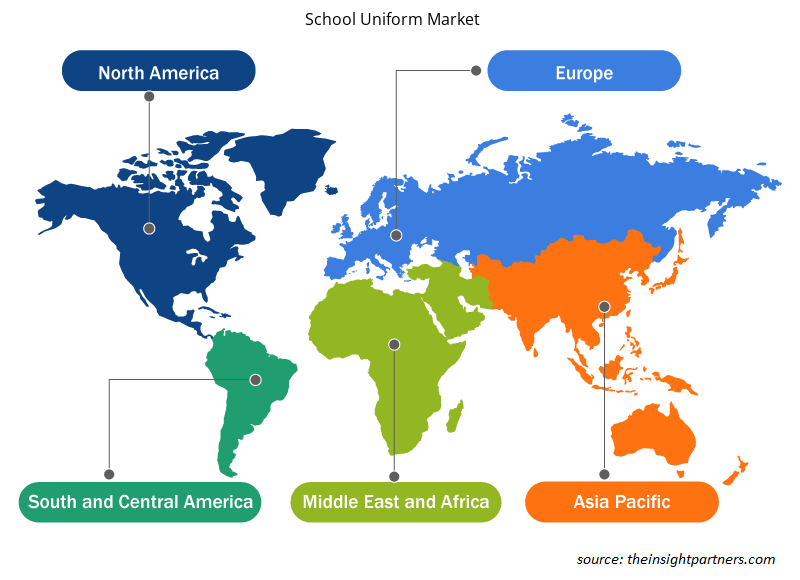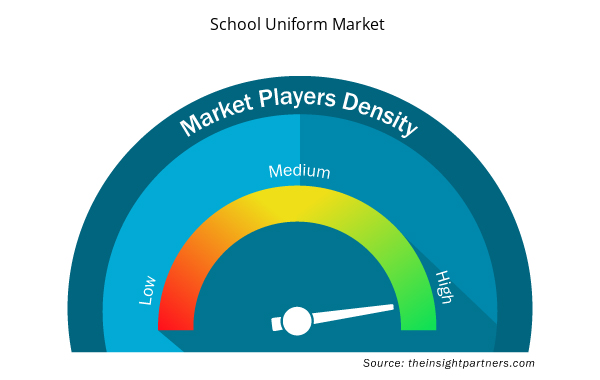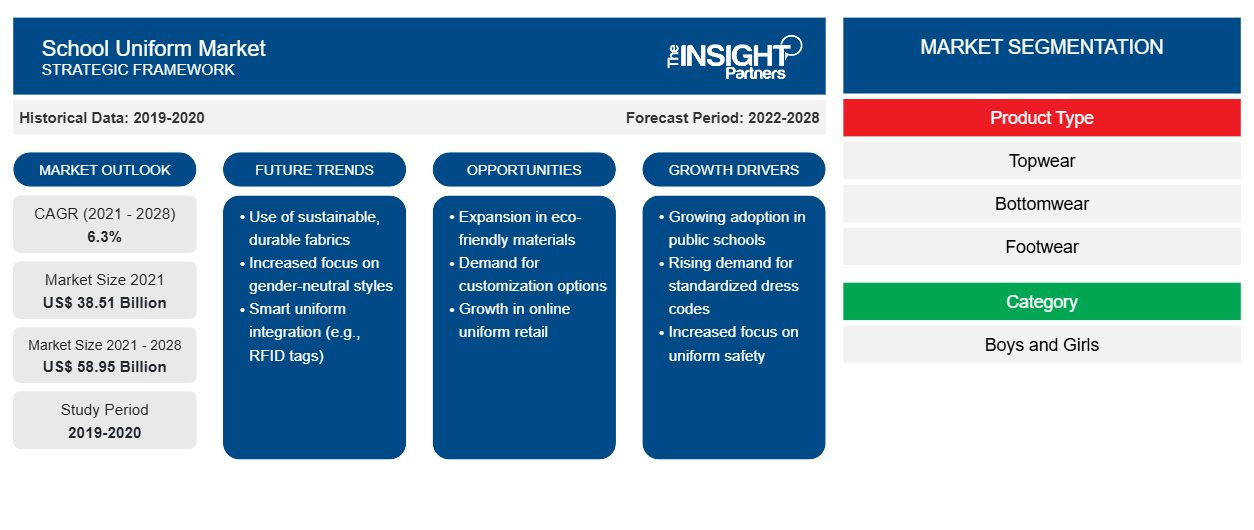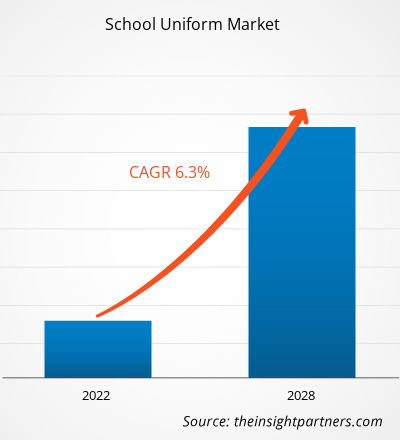[Informe de investigación] El tamaño del mercado de uniformes escolares se valoró en US$ 38.505,66 millones en 2021 y se proyecta que alcance los US$ 58.950,69 millones en 2028; se espera que crezca a una CAGR del 6,3% de 2021 a 2028.
El uniforme escolar es una de las categorías importantes de la industria de la ropa infantil. Los uniformes escolares contribuyen positivamente al comportamiento del niño en la escuela y también desarrollan una afinidad con el aprendizaje. El mercado mundial de uniformes escolares está segmentado por tipo de producto, categoría, canal de distribución y geografía.
En 2020, Asia Pacífico representó la mayor parte de la participación en el mercado mundial de uniformes escolares. El mercado de uniformes escolares en Asia Pacífico está subsegmentado en Australia, China, India, Indonesia, Corea del Sur y el resto de Asia Pacífico. En Asia Pacífico, la demanda de uniformes escolares está aumentando con el crecimiento de la población, los altos ingresos disponibles y el apoyo gubernamental en países como Pakistán, India y Bangladesh. Se prevé además que el aumento en el número de institutos educativos impulse el crecimiento del mercado durante el período de pronóstico.
Personalice este informe según sus necesidades
Obtendrá personalización en cualquier informe, sin cargo, incluidas partes de este informe o análisis a nivel de país, paquete de datos de Excel, así como también grandes ofertas y descuentos para empresas emergentes y universidades.
- Obtenga las principales tendencias clave del mercado de este informe.Esta muestra GRATUITA incluirá análisis de datos, desde tendencias del mercado hasta estimaciones y pronósticos.
Impacto de la pandemia de COVID-19 en el crecimiento del mercado de uniformes escolares
La pandemia de COVID-19 ha alterado drásticamente el estado del sector de bienes de consumo y ha afectado al crecimiento del mercado de uniformes escolares. La implementación de medidas para combatir la propagación del virus ha agravado la situación. El cierre continuo de las escuelas debido a la pandemia ha causado una disrupción sin precedentes en el mercado mundial de uniformes escolares. Con las escuelas permaneciendo mayoritariamente cerradas durante casi dos años, los vendedores y fabricantes de uniformes han sido de los más afectados. Muchos vendedores y fabricantes de uniformes se han enfrentado a una grave crisis de liquidez. La pandemia de COVID-19 también ha afectado a la producción de tela para uniformes escolares. Además, las clases en línea que se han convertido en la nueva normalidad han afectado a la demanda de uniformes escolares. Sin embargo, a medida que los países trabajan para reabrir las escuelas, se espera que la demanda de uniformes escolares aumente a nivel mundial.
Perspectivas de mercado
Diversas iniciativas gubernamentales para mejorar el sector educativo
Varios gobiernos están adoptando iniciativas para mejorar el sector educativo. En junio de 2020, el primer ministro del Reino Unido anunció un programa transformador de reconstrucción de escuelas de 10 años de duración, respaldado por más de 1.300 millones de dólares en financiación. Como parte del plan del primer ministro para mejorar las oportunidades para todos, la inversión se destinará a los edificios escolares en peor estado de toda Inglaterra. Además, China ha realizado importantes inversiones en la mejora del sector educativo y en la ampliación del acceso a la educación para el público en general. Para garantizar que las personas que viven en zonas remotas o las familias con dificultades económicas tengan acceso a las instalaciones educativas, el país ha prestado especial atención. Así, un aumento de diversas iniciativas gubernamentales para mejorar el sector educativo está impulsando el mercado de uniformes escolares.
Perspectivas regionales del mercado de uniformes escolares
Los analistas de Insight Partners explicaron en detalle las tendencias y los factores regionales que influyen en el mercado de uniformes escolares durante el período de pronóstico. Esta sección también analiza los segmentos y la geografía del mercado de uniformes escolares en América del Norte, Europa, Asia Pacífico, Oriente Medio y África, y América del Sur y Central.

- Obtenga los datos regionales específicos para el mercado de uniformes escolares
Alcance del informe sobre el mercado de uniformes escolares
| Atributo del informe | Detalles |
|---|---|
| Tamaño del mercado en 2021 | US$ 38,51 mil millones |
| Tamaño del mercado en 2028 | US$ 58,95 mil millones |
| CAGR global (2021-2028) | 6,3% |
| Datos históricos | 2019-2020 |
| Período de pronóstico | 2022-2028 |
| Segmentos cubiertos | Por tipo de producto
|
| Regiones y países cubiertos | América del norte
|
| Líderes del mercado y perfiles de empresas clave |
|
Densidad de actores del mercado de uniformes escolares: comprensión de su impacto en la dinámica empresarial
El mercado de uniformes escolares está creciendo rápidamente, impulsado por la creciente demanda de los usuarios finales debido a factores como la evolución de las preferencias de los consumidores, los avances tecnológicos y una mayor conciencia de los beneficios del producto. A medida que aumenta la demanda, las empresas amplían sus ofertas, innovan para satisfacer las necesidades de los consumidores y aprovechan las tendencias emergentes, lo que impulsa aún más el crecimiento del mercado.
La densidad de actores del mercado se refiere a la distribución de las empresas o firmas que operan dentro de un mercado o industria en particular. Indica cuántos competidores (actores del mercado) están presentes en un espacio de mercado determinado en relación con su tamaño o valor total de mercado.
Las principales empresas que operan en el mercado de uniformes escolares son:
- Tostada Francesa
- Compañía de fabricación Elder, Inc.
- Ropa escolar de Winterbottom
- Compañía manufacturera Williamson-Dickie
- Trutex Limitada
Descargo de responsabilidad : Las empresas enumeradas anteriormente no están clasificadas en ningún orden particular.

- Obtenga una descripción general de los principales actores clave del mercado de uniformes escolares
Perspectivas de la categoría
Según la categoría, el mercado mundial de uniformes escolares se segmenta en niños y niñas. El segmento de niñas tuvo una mayor participación en el mercado mundial de uniformes escolares en 2020. El uniforme escolar para niñas incluye productos como polos, blusas, pantalones, pantalones cortos, jerséis y vestidos, faldas y faldas pantalón, suéteres, sudaderas con capucha y polares, ropa de abrigo y blazers. El polo, una de las prendas clásicas que funciona para la mayoría de los uniformes escolares, viene en una variedad de materiales y tejidos. Otros accesorios como cinturones , corbatas y accesorios para el cabello también pueden ser parte de los uniformes escolares de las niñas.
Los actores clave que operan en el mercado global de uniformes escolares incluyen French Toast; Elder Manufacturing Company, Inc.; Winterbottom's Schoolwear; Williamson-Dickie Manufacturing Company; Trutex Limited; John Lewis plc; The Uniform Company; Fraylich School Uniforms; Flash Uniforms; y Alinta. Los actores que operan en el mercado están altamente enfocados en el desarrollo de ofertas de productos innovadores y de alta calidad para satisfacer los requisitos del cliente.
Informe Destacado
- Tendencias progresivas del mercado de uniformes escolares para ayudar a los actores a desarrollar estrategias efectivas a largo plazo
- Estrategias de crecimiento empresarial adoptadas por los mercados desarrollados y en desarrollo
- Análisis cuantitativo del mercado de uniformes escolares de 2019 a 2028
- Estimación del tamaño del mercado mundial de uniformes escolares
- Avances recientes para comprender el escenario competitivo del mercado
- Tendencias y perspectivas del mercado de uniformes escolares, así como factores que impulsan y restringen el crecimiento del mercado de uniformes escolares
- Asistencia en el proceso de toma de decisiones destacando las estrategias de mercado que sustentan el interés comercial y conducen al crecimiento del mercado.
- El tamaño del mercado de uniformes escolares en varios nodos
- Descripción detallada y segmentación del mercado, así como la dinámica de la industria de uniformes escolares.
- Tamaño del mercado de uniformes escolares en varias regiones con oportunidades de crecimiento prometedoras
Mercado mundial de uniformes escolares
Por tipo de producto
- Prendas de abrigo
- Ropa interior
- Calzado
- Otros
Por categoría
- Niños
- Chicas
Por canal de distribución
- Supermercados e Hipermercados
- Tiendas especializadas
- Venta minorista en línea
- Otros
Perfiles de empresas
- Tostada Francesa
- Compañía de fabricación Elder, Inc.
- Ropa escolar de Winterbottom
- Compañía manufacturera Williamson-Dickie
- Trutex Limitada
- John Lewis S.A.
- La empresa de uniformes
- Uniformes escolares de Fraylich
- Uniformes Flash
- Alinta
- Análisis histórico (2 años), año base, pronóstico (7 años) con CAGR
- Análisis PEST y FODA
- Tamaño del mercado Valor/volumen: global, regional, nacional
- Industria y panorama competitivo
- Conjunto de datos de Excel



Report Coverage
Revenue forecast, Company Analysis, Industry landscape, Growth factors, and Trends

Segment Covered
This text is related
to segments covered.

Regional Scope
North America, Europe, Asia Pacific, Middle East & Africa, South & Central America

Country Scope
This text is related
to country scope.
Preguntas frecuentes
Based on product type, the topwear segment led the global school uniform market in 2020. The topwear segment of school uniforms mainly includes shirts, polo shirts, blouses, blazers, sweaters, and cardigans. Shirts and blouses are available in different colors, prices, and size ranges. Shirts for school uniforms are available with long and short sleeves. For a few schools, uniforms also include apparel necessary for cold weather, such as hoodies or sweatshirts, sweaters, cardigans, and jackets. In jackets, sweaters, etc., wool is commonly used in combination with other fabrics such as polyester as it is naturally warm, thick, and soft.
Emphasis on sports and extracurricular activities in schools is the key trend for the global school uniform market. Regular physical activities benefit the reduced risk of obesity, which is otherwise a common problem among today’s kids. Sports activities also help reduce chronic muscular tension and blood sugar levels, strengthen lungs, and regulate blood pressure. Students who participate in sports grow up as more energetic individuals. Including physical activities right from childhood will help children make it a part of their routine with ease. Therefore, there is a growing emphasis on sports and extracurricular activities in schools. This, in turn, is creating demand for school sports uniforms such as t-shirts, shorts, sports jerseys, sports jackets, sports lowers, and sports shoes.
The major players operating in the global school uniform market are French Toast; Elder Manufacturing Company, Inc.; Winterbottom's Schoolwear; Williamson-Dickie Manufacturing Company; Trutex Limited; John Lewis plc; The Uniform Company; Fraylich School Uniforms; Flash Uniforms; and Alinta.
Growth in children population and low infant mortality rate are some of the key drivers for the growth of the global school uniform market. Many countries across the globe are experiencing a significant reduction in infant deaths. The reduction in infant deaths can be attributed to factors such as an increase in medical services available to the people. There has been a rise in medical professionals in many countries. Improving female education and nutrition, and increasing use of healthcare services during pregnancy and delivery, has resulted in lower child mortality. Countries such as Japan, Iceland, Singapore, and Finland have low infant mortality rates. Thus, the growth in the children population and low infant mortality rate results in an increase in the school-going population. This, in turn, is expected to aid the demand for school uniforms.
Based on category, the girls segment led the global school uniform market in 2020. School uniform for girls includes products such as polo shirts, blouses, pants, shorts, jumpers and dresses, skirts and skorts, sweaters, hoodies and fleece, outwear and blazers. Other accessories such as belts, ties, and hair accessories can also be a part of girls’ school uniforms.
During the forecast period, Asia-Pacific is anticipated to account for the largest share of the global school uniform market. Asia-Pacific region comprises several developed and developing economies, including China, India, Japan, South Korea, among others. In Asia-Pacific region, the demand for school uniforms is increasing with the growing population, high disposal income, and government support in countries such as Pakistan, India, and Bangladesh. Moreover, various other initiatives by school administrations and government authorities are also bolstering the growth of the school uniform market in this region.
Trends and growth analysis reports related to Consumer Goods : READ MORE..
The List of Companies - School Uniform Market
- French Toast
- Elder Manufacturing Company, Inc.
- Winterbottom's Schoolwear
- Williamson-Dickie Manufacturing Company
- Trutex Limited
- John Lewis plc
- The Uniform Company
- Fraylich School Uniforms
- Flash Uniforms
- Alinta
The Insight Partners performs research in 4 major stages: Data Collection & Secondary Research, Primary Research, Data Analysis and Data Triangulation & Final Review.
- Data Collection and Secondary Research:
As a market research and consulting firm operating from a decade, we have published and advised several client across the globe. First step for any study will start with an assessment of currently available data and insights from existing reports. Further, historical and current market information is collected from Investor Presentations, Annual Reports, SEC Filings, etc., and other information related to company’s performance and market positioning are gathered from Paid Databases (Factiva, Hoovers, and Reuters) and various other publications available in public domain.
Several associations trade associates, technical forums, institutes, societies and organization are accessed to gain technical as well as market related insights through their publications such as research papers, blogs and press releases related to the studies are referred to get cues about the market. Further, white papers, journals, magazines, and other news articles published in last 3 years are scrutinized and analyzed to understand the current market trends.
- Primary Research:
The primarily interview analysis comprise of data obtained from industry participants interview and answers to survey questions gathered by in-house primary team.
For primary research, interviews are conducted with industry experts/CEOs/Marketing Managers/VPs/Subject Matter Experts from both demand and supply side to get a 360-degree view of the market. The primary team conducts several interviews based on the complexity of the markets to understand the various market trends and dynamics which makes research more credible and precise.
A typical research interview fulfils the following functions:
- Provides first-hand information on the market size, market trends, growth trends, competitive landscape, and outlook
- Validates and strengthens in-house secondary research findings
- Develops the analysis team’s expertise and market understanding
Primary research involves email interactions and telephone interviews for each market, category, segment, and sub-segment across geographies. The participants who typically take part in such a process include, but are not limited to:
- Industry participants: VPs, business development managers, market intelligence managers and national sales managers
- Outside experts: Valuation experts, research analysts and key opinion leaders specializing in the electronics and semiconductor industry.
Below is the breakup of our primary respondents by company, designation, and region:

Once we receive the confirmation from primary research sources or primary respondents, we finalize the base year market estimation and forecast the data as per the macroeconomic and microeconomic factors assessed during data collection.
- Data Analysis:
Once data is validated through both secondary as well as primary respondents, we finalize the market estimations by hypothesis formulation and factor analysis at regional and country level.
- Macro-Economic Factor Analysis:
We analyse macroeconomic indicators such the gross domestic product (GDP), increase in the demand for goods and services across industries, technological advancement, regional economic growth, governmental policies, the influence of COVID-19, PEST analysis, and other aspects. This analysis aids in setting benchmarks for various nations/regions and approximating market splits. Additionally, the general trend of the aforementioned components aid in determining the market's development possibilities.
- Country Level Data:
Various factors that are especially aligned to the country are taken into account to determine the market size for a certain area and country, including the presence of vendors, such as headquarters and offices, the country's GDP, demand patterns, and industry growth. To comprehend the market dynamics for the nation, a number of growth variables, inhibitors, application areas, and current market trends are researched. The aforementioned elements aid in determining the country's overall market's growth potential.
- Company Profile:
The “Table of Contents” is formulated by listing and analyzing more than 25 - 30 companies operating in the market ecosystem across geographies. However, we profile only 10 companies as a standard practice in our syndicate reports. These 10 companies comprise leading, emerging, and regional players. Nonetheless, our analysis is not restricted to the 10 listed companies, we also analyze other companies present in the market to develop a holistic view and understand the prevailing trends. The “Company Profiles” section in the report covers key facts, business description, products & services, financial information, SWOT analysis, and key developments. The financial information presented is extracted from the annual reports and official documents of the publicly listed companies. Upon collecting the information for the sections of respective companies, we verify them via various primary sources and then compile the data in respective company profiles. The company level information helps us in deriving the base number as well as in forecasting the market size.
- Developing Base Number:
Aggregation of sales statistics (2020-2022) and macro-economic factor, and other secondary and primary research insights are utilized to arrive at base number and related market shares for 2022. The data gaps are identified in this step and relevant market data is analyzed, collected from paid primary interviews or databases. On finalizing the base year market size, forecasts are developed on the basis of macro-economic, industry and market growth factors and company level analysis.
- Data Triangulation and Final Review:
The market findings and base year market size calculations are validated from supply as well as demand side. Demand side validations are based on macro-economic factor analysis and benchmarks for respective regions and countries. In case of supply side validations, revenues of major companies are estimated (in case not available) based on industry benchmark, approximate number of employees, product portfolio, and primary interviews revenues are gathered. Further revenue from target product/service segment is assessed to avoid overshooting of market statistics. In case of heavy deviations between supply and demand side values, all thes steps are repeated to achieve synchronization.
We follow an iterative model, wherein we share our research findings with Subject Matter Experts (SME’s) and Key Opinion Leaders (KOLs) until consensus view of the market is not formulated – this model negates any drastic deviation in the opinions of experts. Only validated and universally acceptable research findings are quoted in our reports.
We have important check points that we use to validate our research findings – which we call – data triangulation, where we validate the information, we generate from secondary sources with primary interviews and then we re-validate with our internal data bases and Subject matter experts. This comprehensive model enables us to deliver high quality, reliable data in shortest possible time.


 Obtenga una muestra gratuita de este informe
Obtenga una muestra gratuita de este informe